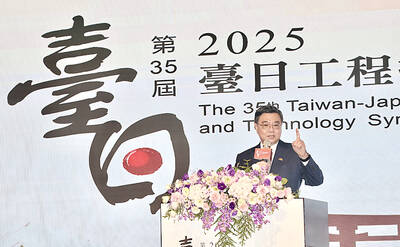Not many people know the name of Japanese architect Matsunosuke Moriyama, but they have all seen his works — whether it is the Presidential Office, the Taipei Guest House, the Control Yuan building or the headquarters of Taiwan Tobacco and Liquor Corp.
The Presidential Office and the Taipei Guest House are the two projects that best represent Moriyama’s works, said the researchers of the book Foreigner in Formosa (異人的足跡), published by the Academia Historica, who revisited the works and life of Moriyama and credited him “the helmsman who shaped the style of public buildings in Taipei.”
The Presidential Office was originally the Taiwan Governor General’s Office during the Japanese colonial era, while the Taipei Guest House was the governor general’s residence.

PHOTO: COURTESY OF ACADEMIA HISTORICA
Huang Chun-ming (黃俊銘), architecture professor at Chung Yuan Christian University, said the location of the Governor General’s Office was determined in 1900, when the Japanese colonial government laid out its first urban planning design for Taipei.
“In the plan, the office faced directly at the Jingfumen (景福門), the East Town Gate built in the Qing Dynasty,” Huang said. “In between the gate and the Governor General’s Office was a large avenue, which is now Ketagalan Boulevard. You can see all the way from Jingfumen to the entrance hall [of the Presidential Office].”
The construction of the Governor General’s Office began in 1912 and it was completed in 1919. For the project, the colonial government held a competition to solicit draft plans from architects. The one pitched by Moriyama was not selected. Instead, the colonial government chose one submitted by Uheijui Nagano, another Japanese architect.
Moriyama later became construction division director at the Governor General’s Office site. He modified Nagano’s original design by adding a 60m-tall tower on the top of the office building, which was viewed by many as an important symbol of Japanese rule.
Huang said Moriyama preferred baroque architecture, which explained the magnificent decorations in the entrance hall.
The Governor General’s Office was later bombed by the US Air Force during World War II. The pillars in the entrance hall were destroyed in the air raid. Nevertheless, one can still see the pedestals of the double-column pillars in the entrance hall today.
The West Wing of the Presidential Office, on the other hand, is the only part of the building that was not damaged during the war.
As smoking was prohibited in most of the Governor General’s Office, Huang said smoking lounges were built on the four corners of the building, adding that they also helped turn the building into a structure that could withstand earthquakes.
Hsueh Chin (薛琴), another professor of architecture at Chung Yuan Christian University, traced the history of the Taipei Guest House and found a rather controversial past during the colonial era.
“The proposal for building the governor general’s residence generated quite a debate at the Imperial Diet in Japan,” Hsueh said. “Back then, Taiwan still needed to be subsidized by Japan, but Taiwan’s governor general wanted to live in a house that was more grandiose than the Imperial Palace of Japan. This sounded ridiculous to members of parliament.”
Shinpei Goto, then head of the civilian affairs bureau, defended the construction, saying: “How can royalty gain the respect of the people if people do not know the kind of places royalty lives?”
Hsueh said Goto’s argument helped him secure approval for the project from the Imperial Diet.
The construction of the governor general’s residence was completed in 1901. Because of the humidity in Taiwan, the wooden structure was soon eroded by termites.
So in 1911, Moriyama was put in charge of a renovation project and he replaced the wooden framework with steel to solve the termite problem. He also expanded the size of the residence and landscaped its gardens.
The renovated residence was also equipped with a Mansard roof — a four-sided roof with a double slope on each side.
Meanwhile, single columns on the balcony of the second floor were turned into pairs of columns, with goat horns or other Greek style ornaments above them.
The chandeliers and wall decorations inside the residence were all gilded, Hsueh said.
The residence was mainly used to house the Japanese royal family when they visited Taiwan, Hsueh said, adding that the governor general himself, in fact, lived in a Japanese-style house built right next to the residence.
“Though the Japanese people tried hard to be westernized after the Meiji Restoration, they still preferred their own culture, so you will see the combination of Western and Japanese architecture in Japan a lot,” Hsueh said.
A graduate of the architecture department at Tokyo Imperial University, Moriyama was one of many architects who traveled to Taiwan in 1907. Though born into a political family, he chose to dedicate his life to architecture instead. His professor was Kingo Tatsuno, who learned from British architect Josiah Conder.
Conder was invited to teach at Tokyo Imperial University and educated Japanese architects on Western-style buildings during the Meiji Restoration.
As director of the construction division of the Governor General’s Office, Moriyama designed and supervised the execution of the public building projects in Taiwan. Aside from the Presidential Office and the Taipei Guest House, Moriyama was also in charge of constructing the city government offices in Taichung and Tainan.
Chinese Culture University professor Lee Chien-lang (李乾朗) said Moriyama came to Taiwan during the Taisho era in Japan. Japanese architects had traveled to Taiwan both before and after Moriyama arrived, he said.
“Unlike his peers, however, Moriyama preferred the baroque architectural style, but he also tried to incorporate his personal style into his works,” Lee said.
Lee said South Korea debated a decade ago whether it should keep its Japanese General Government Building. The South Korean government eventually decided to tear it down because it was a symbol of the Japanese colonial era.
“The General Government Building was built right in the front of the Imperial Palace in South Korea and this was seen as a deliberate humiliation, a slap in the face of Koreans,” he said.
To build the Governor General’s Office in Taipei, the Japanese had to relocate the ancestral temples of the Lin (林) and Chen (陳) families, the two largest clans in Taiwan, Lee said.
That, however, was not deemed a humiliation because both families received compensation for the relocations, Lee said.
Moriyama returned to Japan in 1921 and continued to engage in architectural design in the private sector. When he designed the Imperial Pavilion at Shinjuku Gyoen National Garden in Japan, he also applied Taiwanese architectural style and built it with red cypress and bricks imported from Taiwan. The Imperial Pavilion is also known as the Taiwan Pavilion.
Lee said Moriyama helped enlighten the public by constructing these European-style buildings because at the time a lot of Taiwanese did not have much exposure to Western culture.
“They [the buildings] also brought diversity to the Taipei City’s landscape,” he said.

The Ministry of Foreign Affairs (MOFA) yesterday voiced dissatisfaction with the Comprehensive and Progressive Agreement for Trans- Pacific Partnership (CPTPP), whose latest meeting, concluded earlier the same day, appeared not to address the country’s application. In a statement, MOFA said the CPTPP commission had "once again failed to fairly process Taiwan’s application," attributing the inaction to the bloc’s "succumbing to political pressure," without elaborating. Taiwan submitted its CPTPP application under the name "Separate Customs Territory of Taiwan, Penghu, Kinmen and Matsu" on Sept. 22, 2021 -- less than a week after China

ALIGNED THINKING: Taiwan and Japan have a mutual interest in trade, culture and engineering, and can work together for stability, Cho Jung-tai said Taiwan and Japan are two like-minded countries willing to work together to form a “safety barrier” in the Indo-Pacific region, Premier Cho Jung-tai (卓榮泰) yesterday said at the opening ceremony of the 35th Taiwan-Japan Modern Engineering and Technology Symposium in Taipei. Taiwan and Japan are close geographically and closer emotionally, he added. Citing the overflowing of a barrier lake in the Mataian River (馬太鞍溪) in September, Cho said the submersible water level sensors given by Japan during the disaster helped Taiwan monitor the lake’s water levels more accurately. Japan also provided a lot of vaccines early in the outbreak of the COVID-19 pandemic,

Kaohsiung Mayor Chen Chi-mai (陳其邁) on Monday announced light shows and themed traffic lights to welcome fans of South Korean pop group Twice to the port city. The group is to play Kaohsiung on Saturday as part of its “This Is For” world tour. It would be the group’s first performance in Taiwan since its debut 10 years ago. The all-female group consists of five South Koreans, three Japanese and Tainan’s Chou Tzu-yu (周子瑜), the first Taiwan-born and raised member of a South Korean girl group. To promote the group’s arrival, the city has been holding a series of events, including a pop-up

A home-style restaurant opened by a Taiwanese woman in Quezon City in Metro Manila has been featured in the first-ever Michelin Guide honoring exceptional restaurants in the Philippines. The restaurant, Fong Wei Wu (豐味屋), was one of 74 eateries to receive a “Michelin Selected” honor in the guide, while one restaurant received two Michelin stars, eight received one star and 25 were awarded a “Bib Gourmand.” The guide, which was limited to restaurants in Metro Manila and Cebu, was published on Oct. 30. In an interview, Feng Wei Wu’s owner and chef, Linda, said that as a restaurateur in her 60s, receiving an